Current and Prospective Strategies on Detecting and Managing Colletotrichumfalcatum Causing Red Rot of Sugarcane
Abstract
1. Introduction
2. Pathogen, Infection and Transmission
3. Identification of Colletotrichum falcatum
3.1. Traditional Methods
3.2. Serologic Methods
3.3. Molecular Method
3.4. Image Processing Method
3.4.1. Fluorescence Imaging
3.4.2. Thermography in Disease Detection
3.4.3. Hyperspectral Imagery
3.5. DNA/RNA-Based Affinity Biosensor
4. Management of Red Rot Disease
4.1. Agronomic and Cultural Practices
4.2. Physical Treatment
4.3. Chemical Control
4.4. Use of Resistant Varieties against Red Rot
4.5. Biologic Control and Natural Products
5. Legislation (Quarantine)
6. Conclusions and Future Perspectives
Author Contributions
Funding
Acknowledgments
Conflicts of Interest
References
- Purseglove, J.W. Tropical Crops, Monocotyledons; Longman Group Ltd.: London, UK, 1979. [Google Scholar]
- Thangamanil, P.R.; Thiruvengadam, R.; Thillaigovindan, K. Morphological characterization and reaction of partial purified toxin of sugarcane red rot pathogen Colletotrichum falcatum collected from Southern India. Int. J. Agric. Sci. 2013, 3, 60–78. [Google Scholar]
- Gianotto, A.C.; Arruda, P.; Bespalhok, J.; Burnquist, W.W. Sugarcane (Saccharum X officinarum): A Reference Study for the Regulation of Genetically Modified Cultivars in Brazil. Trop. Plant Biol. 2011, 4, 62–89. [Google Scholar] [CrossRef] [PubMed]
- Food and Agricultural Organization of United Nations. Economic and Social Department. The Statistical Division; FAO: Rome, Italy, 2018. [Google Scholar]
- FAO; UNICEF. The State of Food Security and Nutrition in the World: Safe Guarding against Economic Slowdowns and Downturns; UNICEF: Paris, France, 2019. [Google Scholar]
- OECD/FAO. OECD-FAO Agricultural Outlook, OECD Agriculture Statistics (Database); OECD: Paris, France, 2019; p. 162. [Google Scholar] [CrossRef]
- OECD. OECD-FAO Agricultural Outlook 2019–2028; OECD: Paris, France, 2019; pp. 156–162. [Google Scholar] [CrossRef]
- Talukder, M.I.; Alam, M.S. Effect of moist hot air treatment (MHAT) on control of white leaf disease and growth of sugarcane. Pak. Sugar J. 2000, 15, 16–21. [Google Scholar]
- Rott, P.; Bailey, R.A.; Comstock, J.C.; Croft, B.J.; Saumtally, A.S. A Guide to Sugarcane Disease; Cirad. Issct, Cirad Publication Services: Montepellier, France, 2000; p. 339. [Google Scholar]
- Sharma, R.; Tamta, S. A Review on red rot: The “cancer” of sugarcane. J. Plant Pathol. Microbiol. 2015, 1, 1–8. [Google Scholar] [CrossRef]
- Singh, O.; Waraitch, K.S. Effect of Wilt and Red Rot Induced Disease Stress on Quality Deterioration of Sugarcane. Sugarcane Pathol. Newsl. 1981, 27, 9–25. [Google Scholar]
- Smith, B.J.; Black, L.L. Morphological, cultural and pathogenic variation among Colletotrichum species isolated from strawberry. Plant Dis. 1990, 74, 69–76. [Google Scholar] [CrossRef]
- Bharti, Y.P.; Vishwakarma, S.K.; Kumar, A.; Singh, A.; Sharma, M.L.; Shukla, D.N. Physiological and Pathological Aspects of some new isolates of Colletotricum falcatum causing Red rot disease in Saccharum spp.complex. Acta Phytopathol. Entomol. Hung. 2012, 47, 35–50. [Google Scholar] [CrossRef]
- Ghazanfar, M.U.; Kamran, S. Evaluation of Different Plant Extracts against Colletotrichum falcatum Causing Red Rot in Sugarcane under Lab Conditions. J. Environ. Agric. 2016, 1, 68–73. [Google Scholar]
- Malathi, P.; Viswanathan, R.; Padmanaban, P.; Mohanraj, D.; Ramesh, A. Compatibility of biocontrol agents with fungicides against red rot disease of sugarcane. Sugar Tech 2002, 4, 131–136. [Google Scholar] [CrossRef]
- Patel, P.; Shah, R.; Joshi, B.; Ramar, K.; Natarajan, A. Molecular identification and biocontrol activity of sugarcane rhizosphere bacteria against red rot pathogen Colletotrichum falcatum. Biotechnol. Rep. 2019, 21, e00317. [Google Scholar] [CrossRef]
- Singh, D.; Tiwari, A.K.; Mall, S.; Shukla, B.; Ahmad, I.Z.; Rao, G.P. Morpholoical and molecular diversity among C. falcatum isolates causing red rot disease of sugarcane in Uttar Pradesh. In Proceedings of the 10th Pathology Workshop, Nanning, China, 7–11 May 2012; p. 9. [Google Scholar]
- Sharma, G.; Singh, J.; Arya, A.; Sharma, S.R. Biology and Management of Sugarcane Red Rot: A Review. Plant Arch. 2017, 17, 775–784. [Google Scholar]
- Viswanathan, R.; Padmanaban, P.; Selvakumar, R. Emergence of New Pathogenic Variants in Colletotrichum falcatum, Stalk Infecting Ascomycete in Sugarcane: Role of Host Varieties. Sugar Tech 2019, 22, 473–484. [Google Scholar] [CrossRef]
- Cooper, R.M.; Flood, J.; Rees, R. Ganoderma boninense in oil palm plantations: Current thinking on epidemiology, resistance and pathology. Planter 2011, 87, 515–526. [Google Scholar]
- Hassan, M.N.; Afghan, S.; Hafeez, F.Y. Suppression of red rot caused by Colletotrichum falcatum on sugarcane plants using plant growth-promotin grhizobacteria. BioControl 2010, 55, 531–542. [Google Scholar] [CrossRef]
- Duttamajumder, S.K. Red Rot of Sugarcane; Indian Institute of Sugarcane Research: Lucknow, India, 2008; pp. 1–8. [Google Scholar]
- Viswanathan, R.; Rao, G.P. Disease scenario and management of major sugarcane diseases in India. Sugar Tech 2011, 13, 336–353. [Google Scholar] [CrossRef]
- Satyavir. Red Rot of Sugarcane Current Scenario. Indian Phytopathol. 2003, 56, 245–254. [Google Scholar]
- Hossain, M.I.; Uddin, M.J.; Rahman, M.S. Evaluation of Some Sugarcane Genotypes against Red Rot (Colletotrichum falcatum Went.) Disease. Bangladesh J. Sugarcane 2015, 36, 113–118. [Google Scholar]
- Nithya, K.; Bukhari, K.; Valluvaparidasan, V.; Paranidharan, V.; Velazhahan, R. Molecular detection of Colletotrichum falcatum causing red rot disease of sugarcane (Saccharum officinarum) using a scar marker. Ann. Appl. Biol. 2012, 160, 168–173. [Google Scholar] [CrossRef]
- Malathi, P.; Viswanathan, R.; Sundar, R.A.; Padmanaban, P.; Prakasam, N.; Mohanraj, D.; Joth, R. Phylogenetic Analysis of Colletotrichum falcatum Isolates Causing Red Rot in Sugarcane. J. Sugarcane Res. 2011, 1, 69–74. [Google Scholar]
- Tiwari, A.K.; Singh, A.; Singh, S.P.; Dagar, A.; Kumari, K.; Kumar, D.; Pandey, N.; Kumar, P. An Overview of Major Fungal Diseases of Sugarcane in India: Detection and Management Strategies. Molecular Markers in Mycology, Fungal Biology; Springer International Publishing: Cham, Switzerland, 2017; pp. 275–304. [Google Scholar]
- Sutton, B.C.; Bailey, J.A.; Jeger, M.J. Colletotrichum: Biology, Pathology and Control; CAB International: Wallingford, UK, 1992; pp. 1–26. [Google Scholar]
- Chakrabarty, P.; Chavhan, R.; Sable, S.; Narwade, A.; Monga, D.; Khadi, B. Development of sensitive molecular diagnostic tools for detection of economically important fungal pathogens of cotton. In Proceedings of the World Cotton Research Conference-4, Lubbock, TX, USA, 10–14 September 2007. [Google Scholar]
- Abbas, H.; Anwar, S.A.; Javed, N.; Iqbal, M.A.; Abid, N. Morphological variability among isolates of Colletotrichum falcatum Went; Infecting four cultivars of sugarcane. Pak. J. Phytopathol. 2010, 22, 101–104. [Google Scholar]
- Kuckenberg, J.; Tartachnyk, I.; Noga, G. Temporal and spatial changes of chlorophyll fluorescence as a basis for early and precise detection of leaf rust and powdery mildew infections in wheat leaves. Precis. Agric. 2009, 10, 34–44. [Google Scholar] [CrossRef]
- Phoulivong, S.; Cai, L.; Chen, H.; Mckenzie, E.H.; Abdelsalam, K.; Chukeatirote, E.; Hyde, K.D. Colletotrichum gloeosporioides is not a common pathogen on tropical fruits. Fungal Divers. 2010, 44, 33–43. [Google Scholar] [CrossRef]
- Viswanathan, R.; Padmanaban, P.; Mohanraj, D.; Jothi, R. Indirect-ELISA technique for the detection of the red rot pathogen in sugarcane (Saccharum spp. hybrid) and resistance screening. Indian J. Agril. Sci. 2000, 70, 8–11. [Google Scholar]
- Mehnaz, S.; Bauer, J.S.; Gross, H. Complete genome sequence of the sugar cane endophyte Pseudomonas aurantiaca PB-St2, a disease-suppressive bacterium with antifungal activity toward the plant pathogen Colletotrichum falcatum. Genome Announc. 2014, 2, e01108-13. [Google Scholar] [CrossRef] [PubMed]
- Uddin, M.S.; Talukdar, M.I.; Rahman, M.S. Screening of red rot genotypes of sugarcane in Bangladesh. Bangladesh J. Sugarcane 2013, 33–34, 5–8. [Google Scholar]
- Hiermath, L.; Naik, R.G. Rapid diagnosis of sugarcane red rot by Dot Immune Binding Assay (DIBA) technique. Indian J. Biotechnol. 2004, 3, 542–545. [Google Scholar]
- Khalid, A.I.; Bukhari, K.; Nithya, V.; Valluvaparidasan, V.; Paranidharan, R.; Velazhahan, M. Detection of Colletotrichum falcatum causing red rot of sugarcane by enzyme linked immune sorbent assay. Arch. Phytopathol. Plant Prot. 2012, 45, 823–830. [Google Scholar]
- Cai, L.; Hyde, K.; Taylor, P.; Weir, B.; Waller, J.; Abang, M.; Zhang, J.; Yang, Y.; Phoulivong, S.; Liu, Z. A polyphasic approach for studying Colletotrichum. Fungal Divers. 2009, 39, 183–204. [Google Scholar]
- Hyde, K.D.; Chomnunti, P.; Crous, P.W.; Groenewald, J.Z.; Damm, U.; KoKo, T.W.; Shivas, R.G.; Summerell, B.A.; Tan, Y.P. A case for re-inventory of Australia’s plant pathogen. Persoonia 2010, 25, 50–60. [Google Scholar] [CrossRef]
- Shivas, R.G.; Tan, Y.P. A taxonomic re-assessment of Colletotrichum acutatum, introducing C. fioriniae comb. et stat. nov. and C. simmondsii sp. nov. Fungal Diver. 2009, 39, e122. [Google Scholar]
- Weir, B.S.; Johnston, P.R.; Damm, U. The Colletotrichum gloeosporioides species complex. Stud. Mycol. 2012, 73, 115–180. [Google Scholar] [CrossRef] [PubMed]
- Arade, P.C.; Singh, P.; Mahatma, M. Characterization of Colletotrichum falcatum Went. Causing red rot in sugarcane complex. Bioscan 2014, 9, 375–379. [Google Scholar]
- Bayraktar, H.; Dolar, F.S. Genetic diversity of wilt and root rot pathogens of chickpea, as assessed by RAPD and ISSR. Turk. J. Agric. For. 2009, 33, 1–10. [Google Scholar]
- Zhang, L.J.; Dai, S.L. Genetic variation within and among populations of Orychophragmu sviolaceus (Cruciferae) in China as detected by ISSR analysis. Genet. Resour. Crop Evol. 2010, 57, 55–64. [Google Scholar] [CrossRef]
- Singh, K.; Singh, R.P. Red rot. In Sugarcane Diseases—Major Diseases; Red, R., Ricaud, C., Egan, B.T., Gillaspie, A.G., Hughes, C.G., Eds.; Elsevier: Amsterdam, The Netherlands, 1989; pp. 169–188. [Google Scholar]
- Shahnazi, S.; Meon, S.; Ebrahimi, M. Characterisation, differentiation and biochemical diversity of Fusarium solani and Fusarium proliferatum based on cellular fatty acid profiles. Arch. Phytopathol. Plant Prot. 2013, 1–9. [Google Scholar] [CrossRef]
- Viswanathan, R.; Prasanth, C.N.; Malathi, P.; Sundar, A.R. Draft genome sequence of Colletotrichum falcatum—A prelude on screening of red rot pathogen in sugarcane. J. Genom. 2016, 4, 1. [Google Scholar] [CrossRef][Green Version]
- Scindiya, M.; Malathi, P.; Kaverinathan, K.; Viswanathan, R.; Sundar, A.R. Molecular characterization of pathogenicity gene homologs in Colletotrichum falcatum causing red rot in sugarcane. Sugar Tech 2017, 19, 563–572. [Google Scholar] [CrossRef]
- Nandakumar, M.; Malathi, P.; Sundar, A.R.; Viswanathan, R. Use of Green Fluorescent Protein Expressing Colletotrichum falcatum the Red Rot Pathogen for Precise Host–Pathogen Interaction Studies in Sugarcane. Sugar Tech 2020, 22, 112–121. [Google Scholar] [CrossRef]
- Padhy, J.B.; Kumar, D.D.; Manish, L.; Lavanya, C. Leaf Disease Detection Using K-Means Clustering and Fuzzy Logic Classifier. IJESTA 2016, 2, 5. [Google Scholar]
- Khan, A.; Yadav, M.; Singh, A.S. Image Processing Based Disease Detection for sugarcane. Int. J. Adv. Res. Ideas Innov. Technol. 2017, 3, 497–502. [Google Scholar]
- Berdugo, C.A.; Zito, R.; Paulus, S.; Mahlein, A.K. Fusion of sensor data for the detection and differentiation of plant diseases in cucumber. Plant Pathol. 2014, 63, 1344–1356. [Google Scholar] [CrossRef]
- Bürling, K.; Hunsche, M.; Noga, G. Use of blue-green and chlorophyll fluorescence measurements for differentiation between nitrogen deficiency and pathogen infection in winter wheat. J. Plant Physiol. 2011, 168, 1641–1648. [Google Scholar] [CrossRef] [PubMed]
- Scholes, J.D.; Rolfe, S.A. Chlorophyll fluorescence imaging as tool for understanding the impact of fungal diseases on plant performance: A phenomics perspective. Funct. Plant Biol. 2009, 36, 880–892. [Google Scholar] [CrossRef] [PubMed]
- Oerke, E.; Steiner, U.; Dehne, H.W.; Lindenthal, M. Thermal imaging of cucumber leaves affected by downy mildew and environmental conditions. J. Exp. Bot. 2006, 57, 2121–2132. [Google Scholar] [CrossRef]
- Stoll, M.; Schultz, H.R.; Baecker, G.; Berkelmann-Loehnertz, B. Early pathogen detection under different water status and the assessment of spray application in vineyards through the use of thermal imagery. Precis. Agric. 2008, 9, 407–417. [Google Scholar] [CrossRef]
- Oerke, E.C.; Fröhling, P.; Steiner, U. Thermographic assessment of scab disease on apple leaves. Precis. Agric. 2011, 12, 699–715. [Google Scholar] [CrossRef]
- Jafari, M.; Minaei, S.; Safaie, N. Detection of pre-symptomatic rose powdery-mildew and gray-mold diseases based on thermal vision. Infrared Phys. Tech. 2017, 85, 170–183. [Google Scholar] [CrossRef]
- Kumar, N.; Jhang, T.; Satyavir, N.; Sharma, T.R. Molecular and Pathological Characterization of Colletotrichum falcatum Infecting Subtropical Indian Sugarcane. J. Phytopathol. 2010, 159, 260–267. [Google Scholar] [CrossRef]
- Hillnhütter, C.; Mahlein, A.K.; Sikora, R.A.; Oerke, E.C. Remote sensing to detect plant stress induced by Heterodera schachtii and Rhizoctonia solani in sugar beet fields. Field Crops Res. 2011, 122, 70–77. [Google Scholar] [CrossRef]
- Apan, A.; Held, A.; Phinn, S.; Markley, J. Detecting sugarcane ‘orange rust’ disease using EO-1 Hyperion hyperspectral imagery. Int. J. Remote Sens. 2004, 25, 489–498. [Google Scholar] [CrossRef]
- Maryam, K.; Khairunniza, B.; Biswajeet, P. Geospatial technologies for detection and monitoring of Ganoderma basal stem rot infection in oil palm plantations: A review on sensors and techniques. Geocarto Int. 2018, 33, 260–276. [Google Scholar]
- Apan, A.; Held, A. In-House Workshop on Hyperion Data Processing: Echoing the Sugarcane Project Experience (Black Mountain Laboratories, Canberra: CSIRO Land and Water); Black Mountain Laboratories: Canberra, Australia, 2002. [Google Scholar]
- Eun, A.J.C.; Wong, S.M. Molecular beacons: A new approach to plant virus detection. Phytopathology 2000, 90, 269–275. [Google Scholar] [CrossRef] [PubMed]
- Ivnitski, D.; Abdel-Hamid, I.; Atanasov, P.; Wilkins, E.; Stricker, S. Application of electrochemical biosensors for detection of food pathogenic bacteria. Electroanalysis 2000, 12, 317–325. [Google Scholar] [CrossRef]
- Sandeep, J.; Chahal, S.S. Molecular and morpho-pathological variation in Bipolarisoryzae (Breda de Haan) shoem causing brown spot of rice in North India. Crop Improv. 2011, 38, 103–108. [Google Scholar]
- Agnihotri, V.P. Current sugarcane disease scenario and management strategies. Indian Phytopathol. 1996, 49, 109–126. [Google Scholar]
- Gupta, R.N.; Sah, S.B.; Kumar, S.; Kumar, A.; Kishore, C.; Chand, G. Impact of red rot disease on nutrient status of sugarcane. Int. J. Curr. Microbiol. App. Sci. 2018, l7, 3533–3538. [Google Scholar]
- Talukder, M.I.; Kamal, M.M.; Iqbal, M.; Rahman, S. Bangladesh Akher Rog Balai Somuho O Tar Pratikar; Bangladesh Sugarcane Research Institute: Ishurdi, Pabna, Bangladesh, 2010; pp. 5–10. [Google Scholar]
- Anower, S.; Khan, H.W.A.; Chatta, A.A. Integrated management of sugarcane diseases and insects in Pakistan. In Proceedings of the International Symposia on Sustainable Sugarcane and Sugar Production Technologies, Nanning, China, 29 November–2 December 2004; pp. 468–471. [Google Scholar]
- Subhani, M.N.; Chaudhry, M.A.; Khaliq, A.; Muhammad, F. Efficacy of Various Fungicides against Sugarcane Red Rot (Colletotrichum falcatum). Int. J. Agric. Biol. 2008, 10, 725–727. [Google Scholar]
- Bharadwaj, N.; Sahu, R.K. Evaluation of some fungicides, botanicals and essential oils against the fungus Colletotrichum falcatum causing red rot of sugarcane. Bioscan 2014, 9, 175–178. [Google Scholar]
- Malathi, P.; Viswanathan, R. Role of microbial chitinase in the biocontrol of sugarcane red rot caused by Colletotrichum falcatum Went. Electron. J. Plant Breed. 2013, 6, 17–23. [Google Scholar]
- Rahman, M.S.; Talukder, M.I.; Iqbal, M.; Begum, F.; Khatun, S. Reaction of some sugarcane genotypes against red rot (Colletotrichum falcatum Went.) disease. Indian Sugar 2009, 59, 35–40. [Google Scholar]
- Kumar, A. Effect of Thiophanate Methyl on Red Rot Disease (Colletotrichum falcatum) and Yield Attributes of Sugarcane. J. Pharmacogn. Phytochem. 2017, 163–167. Available online: http:www.phytojournal.com (accessed on 1 July 2009).
- Alexander, K.C.; Rao, M.M. Comparative evaluation of genotypes in the centres in India for resistance to red rot and smut. In Proceedings of the Diamond Jubilee Symposium of Sugarcane Breeding Institute, Sugarcane Breeding Station, Coimbatore, India, 25 September 1972; pp. 12–24. [Google Scholar]
- Babu, C.N.; Koodalingram, U.S.; Nataranjan, R.M.; Santhi, P.; Govindaraj, P. Genetic inhencement of Sugarcane (Scharachum sp. Hybrids) for resistance to red rot disease and economic traits. J. Agric. Sci. 2009, 4, 97–107. [Google Scholar]
- Prathima, P.; Suparna, T.; Anishma, S.; Punnya, R.; Ramalashmi, K. Cloning and characterization of a differentially regulated invertase inhibitor gene during sucrose accumulation in sugarcane. J. Sugarcane Res. 2014, 4, 21–28. [Google Scholar]
- Singh, R.K.; Kumar, P.; Tiwari, N.N.; Singh, S.P.; Tiwari, A.K.; Kumar, A. Role of endochitinase gene and efficacy of Trichoderma against Colletotrichum falcatum Went. Causing red rot disease in sugarcane. Sugar Tech 2014, 16, 180–188. [Google Scholar] [CrossRef]
- Nayyar, S.; Sharma, B.K.; Kaur, A.; Kalia, A.; Sanghera, G.S.; Thind, K.S.; Sandhu, J.S. Red rot resistant transgenic sugarcane developed through expression of β-1, 3-glucanase gene. PLoS ONE 2017, 12, 1–16. [Google Scholar] [CrossRef]
- Available online: http://agropedia.iitk.ac.in/content/varieties-sugarcane (accessed on 1 July 2009).
- Rahman, M.S.; Khatun, K.; Rahman, K. Sugarcane and sugar industry in Bangladesh: An Overview. Sugar Tech 2016, 18, 627–635. [Google Scholar] [CrossRef]
- Uddin, M.J.; Rahman, M.S.; Hossain, M.I. Pathological Study of Sugarcane Variety BSRI Akh 45 Resistant to Red Rot Disease. Eco-Friendly Agric. J. 2016, 9, 60–62. [Google Scholar]
- Bhardwaj, G.; Shah, R.; Joshi, B.; Patel, P. Klebsiellapn eumoniae VRE36 as a PGPR isolated from Saccharum officinarum cultivar Co99004. J. Appl. Biol. Biotechnol. 2017, 5, 47–52. [Google Scholar] [CrossRef]
- Katiyar, D.; Hemantaranjan, A.; Singh, B. Application of Plant Growth Promoting Rhizobacteria in Promising Agriculture: An Appraisal. J. Plant Physiol. Pathol. 2017, 5, 2. [Google Scholar] [CrossRef]
- Katiyar, A.; Hemantaranjan, B.; Singh, A.K.; Malakar, D. Isolation and characterization of plant growth promoting rhizobacteria Enterobacter hormaechei and their suppression efficacy against Colletotrichum falcatum in combination with Chitosan. Int. J. Plant Soil Sci. 2017, 14, 1–12. [Google Scholar] [CrossRef]
- Hassan, M.N.; Afghan, S.; Hafeez, F.Y. Biological Suppression of Sugarcane Red Rot by Bacillus spp. Under Field Conditions. J. Plant Pathol. 2012, 94, 325–329. [Google Scholar]
- Yadav, R.L.; Singh, S.N.; Srivastava, R.J.; Lal, S.K.; Awasthi Joshi, B.B. Use of Trichorderma harzium for the control of red rot disease of sugarcane. Sugarcane Int. 2008, 26, 28–33. [Google Scholar]
- Imtiaj, A.; Alam, S.M.; Islam, A.K.M.R.; Alam, S.; Lee, T.S. In vitro studies on Colletotrichum falcatum the causal of red rot disease of sugarcane. Eurasian J. Agric. Environ. Sci. 2007, 2, 511–517. [Google Scholar]
- Patel, P.; Shah, R.R.; Modi, K.K. Isolation and Characterization of Plant Growth Promoting Potential of Acinetobacter sp.RSC7 Isolated from Saccharum officinarum cultivar Co 671. J. Exp. Biol. Agric. Sci. 2017, 5, 483–891. [Google Scholar] [CrossRef]
- Jaykumar, V.; Bhaskaran, R.; Tsushima, S. Potential of plant extract in combination with bacterial antagonist treatment as biocontrol agent of red rot of sugarcane. Can. J. Microbiol. 2007, 53, 196–206. [Google Scholar] [CrossRef] [PubMed]
- Senthil, N.; Raguchander, T.; Viswanathan, R.; Samiyappan, R. Talc formulated fluorescent Pseudomonads for sugarcane red rot suppression and enhanced yield under field conditions. Sugar Tech 2003, 5, 37–43. [Google Scholar] [CrossRef]
- Malathi, P.; Padmanaban, P.; Viswanathan, R.; Mohanraj, D. Interaction between Colletotrichum falcatum pathotypes and biocontrol agents. Arch. Phytopathol. Plant Prot. 2008, 41, 311–317. [Google Scholar] [CrossRef]
- Singh, V.; Srivastava, R.L.; Awasthi, S.K.; Joshi, B.B. Biological control of red rot disease of sugarcane through Trichoderma harzianum and Trichoderma viride. Ind. Phytopathol. 2008, 61, 486–491. [Google Scholar]
- Anonymous. Krish Diary, Agricultural Information Service; Department of Agricultural Extension (DAE): Khamarbari, Bangladesh, 2016; pp. 54–55. [Google Scholar]
- Anonymous. Proceedings and Recommendations. All India Coordinated Project on Sugarcane; Indian Institute of Sugarcane Research: Lucknow, India, 1998; pp. 10–15. [Google Scholar]
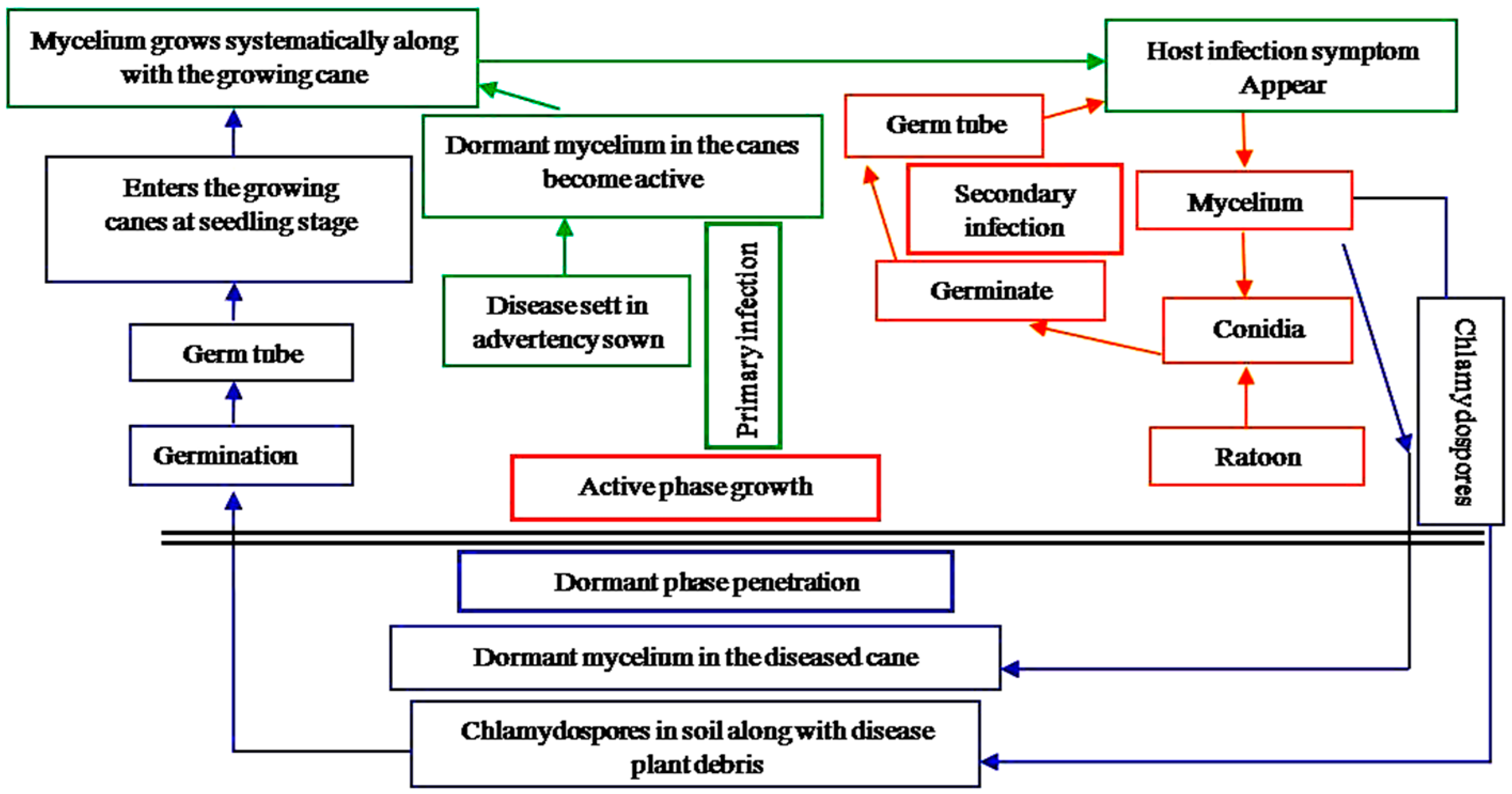
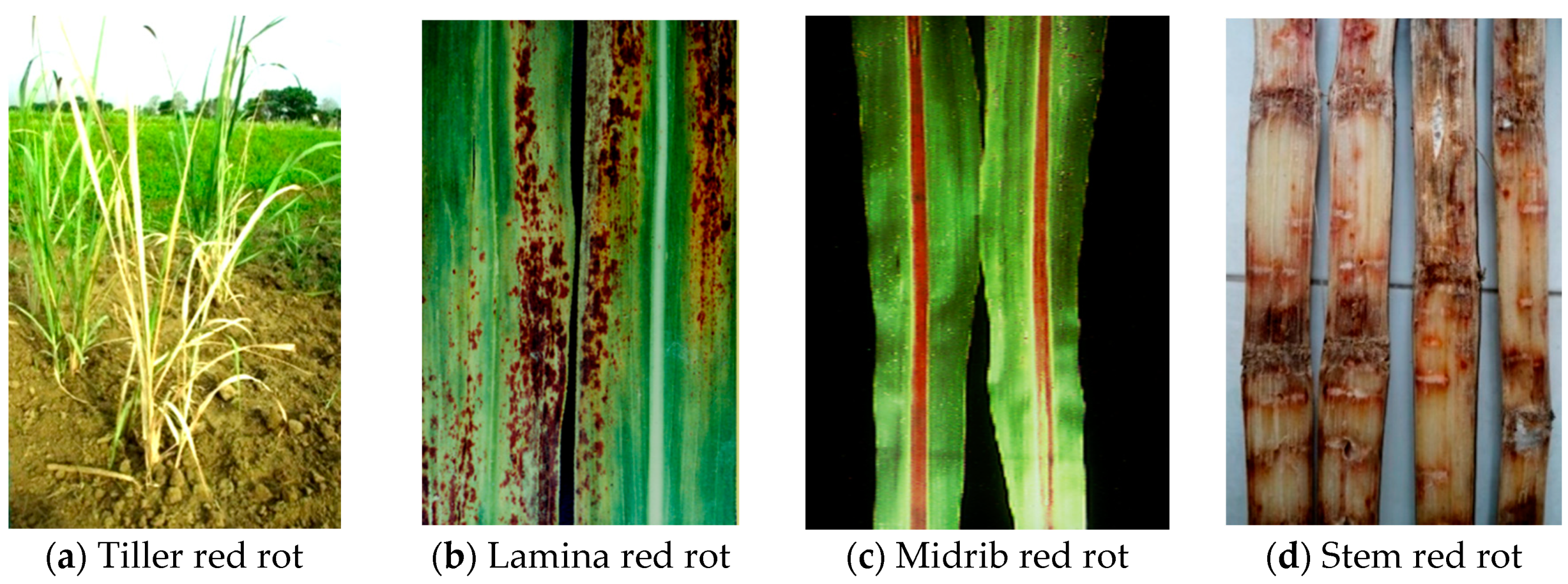
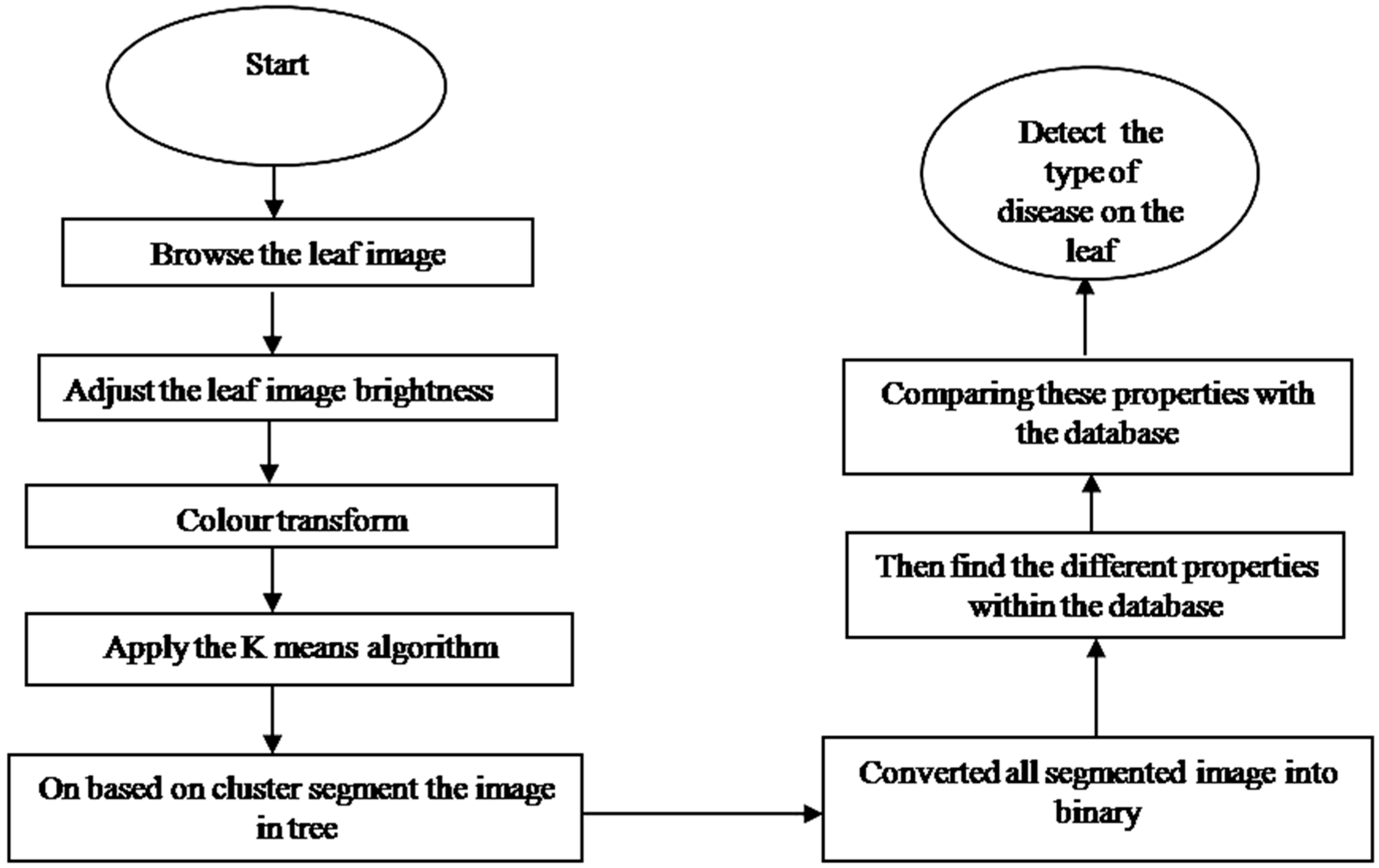
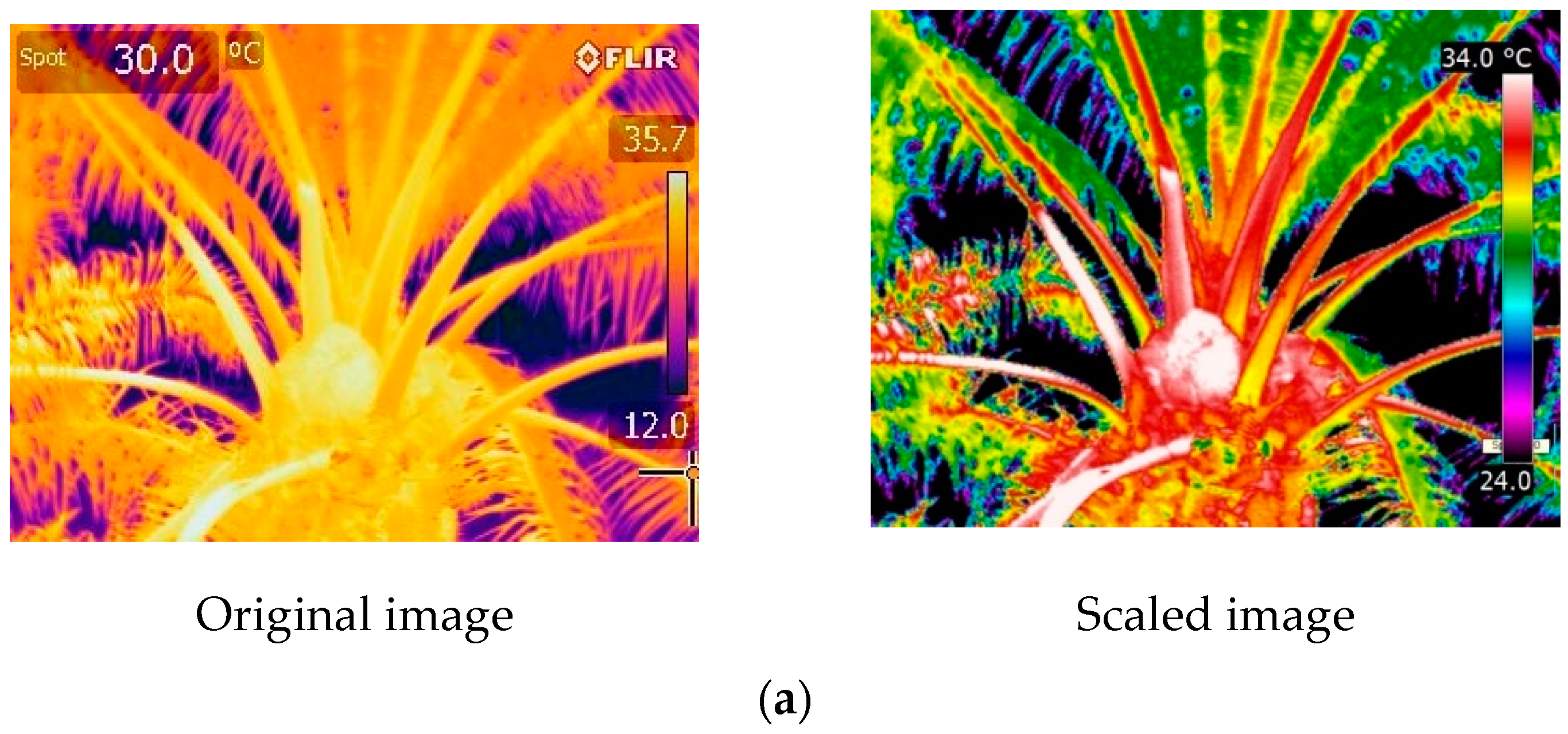
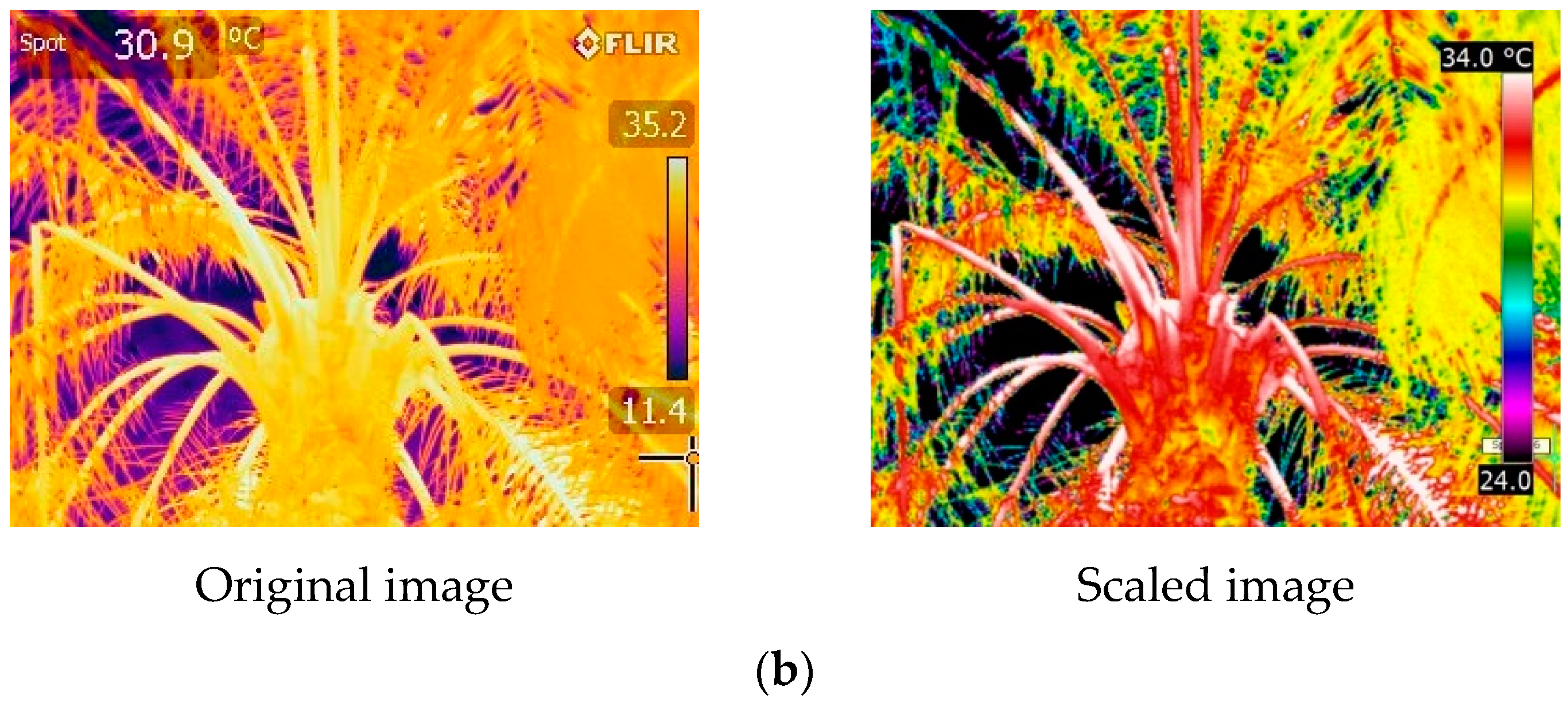
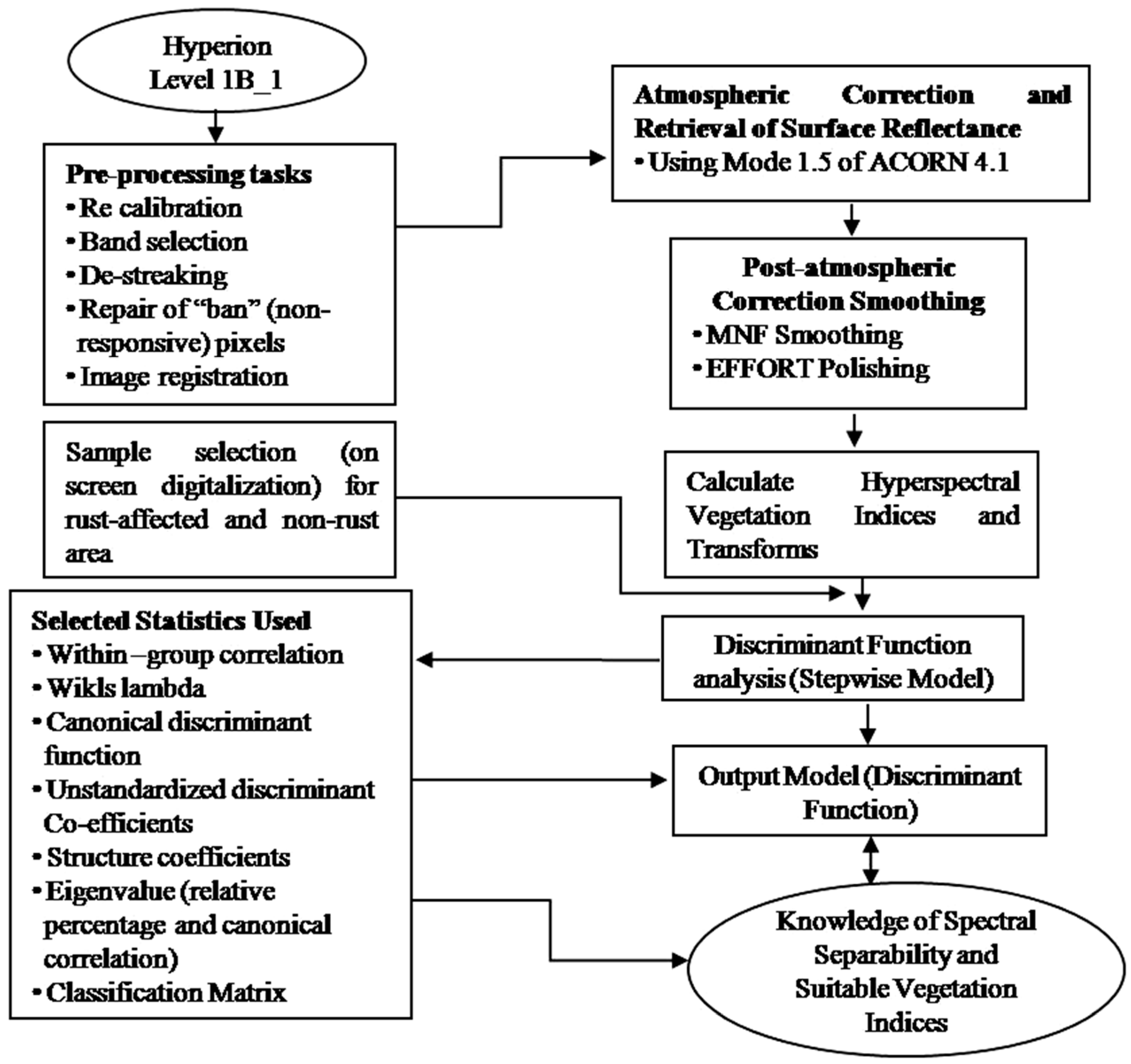
| Accession Number | Sequence Length (bp) | Product | Source | Year of Release |
|---|---|---|---|---|
| NR144793 | 539 | 5.8S rDNA | CBS 127,945 | 2018 |
| MH868869 | 894 | large subunit ribosomal RNA gene | strain CBS 275.54 | 2020 |
| KC790965 | 583 bp | 5.8S ribosomal RNA | strain LC0885 | 2014 |
| KU220963 | 553 bp | 5.8S ribosomal RNA | isolate RR03 | 2016 |
| MK850182 | 584 bp | 5.8S rDNA | isolate I-2 | 2019 |
| MN636356 | 582 bp | 5.8S rDNA | isolate I-39 | 2019 |
| MK937676 | 492 bp | 5.8S rDNA | strain 1802020746Q | 2019 |
| NR144793 | 539 bp | 5.8S ribosomal RNA | strain CBS 127,945 | 2018 |
| AF275524 | 556 bp | small subunit ribosomal RNA gene | strain A97 (CBS 252.59) | 2000 |
| AF275543 | 568 bp | large subunit ribosomal RNA gene | strain A97 (CBS 252.59) | 2014 |
| JQ005772 | 539 bp | ITS1, 5.8S rRNA gene | strain CBS 147,945 | 2013 |
| KC790965 | 584 bp | ITS1 1.5S complete rRNA, 18s and 28s rRNA partial sequence | strain LC0885 | 2014 |
| MN636354 | 537 bp | 5.8s rRNA | strain I-42 | 2019 |
| JQ005856 | 484 bp | beta-tubulin (TUB2) gene, partial cds | strain CBS147945 | 2013 |
| MK867418 | 750 bp | beta-tubulin (TUB2) gene, partial cds | strain I-40 | 2019 |
| AJ409290 | 545 bp | beta-tubulin (TUB2) gene, partial cds | isolate 80 | 2016 |
| HM171680 | 682 bp | beta-tubulin (TUB2) gene, partial cds | isolate LC885 | 2011 |
| MK867410 | 750 bp | beta-tubulin (TUB2) gene, partial cds | isolate I-19 | 2019 |
| MK867412 | 750 bp | beta-tubulin (TUB2) gene, partial cds | isolate I-24 | 2019 |
| MK867417 | 750 bp | beta-tubulin (TUB2) gene, partial cds | isolate I-38 | 2019 |
| JQ005835 | 252 bp | actin (ACT) gene, partial cds | strain CBS 147,945 | 2013 |
| MK867380 | 272bp | actin (ACT) gene, partial cds | isolate I-5 | 2019 |
| JQ005835 | 252 bp | actin (ACT) gene, partial cds | strain CBS 147,945 | 2013 |
| KP895580 | 253 bp | actin (ACT) gene, partial cds | isolate 238 | 2015 |
| MK867393 | 271 bp | actin (ACT) gene, partial cds | isolate I-27 | 2019 |
| MK867379 | 271 bp | actin (ACT) gene, partial cds | isolate I-2 | 2019 |
| FJ002020 | 152 bp | glyceraldehyde 3-phosphate dehydrogenase gene, partial cds | isolate Cf64-8 | 2019 |
| MK867433 | 150 bp | glyceraldehyde-3-phosphate dehydrogenase gene, partial cds | isolate I-27 | 2019 |
| FJ001997 | 152 bp | glyceraldehyde-3-phosphate dehydrogenase gene, partial cds | Cf419 | 2019 |
| FJ002002 | 152 bp | glyceraldehyde-3-phosphate dehydrogenase gene, partial cds | isolate Cf86032C | 2019 |
| JQ005793 | 280 bp | Chitin synthase 1 (CHS1) gene, partial cds | strain CBS147945 | 2013 |
| JQ005814 | 385 bp | histone (HIS3) gene partial cds | strain CBS147945 | 2013 |
| Classification | Bio-Agent | Effect | Recommendation | References |
|---|---|---|---|---|
| Bacteria | Acinetobacter sp. PK9 Bacillus safensis B1 Bacillus megaterium PK2 Cronobacter muytjensii VRE6 Enterobacter sp. RSC32 Enterobacter cloacae VRE7 Pseudomonas plecoglossicida S2 Ochrobactrum anthropi TRD11 Ochrobactrum intermediumTRD14 Stenotrophomonas acidaminiphila Pseudomonas plecoglossicida S2 Sphingobacterium thalpophilumRSC24 | Dual culture test indicated 36% to 60% inhibition. | Field evaluation required | Patel et al. [16] Patel et al. [91] |
| Pseudomonas putida NH-50 | Reduced disease severity by 44–60% in different field trials | This strain possesses other plant growth characteristics and can be used as a bio-pesticide for sugarcane crop | Hassan et al. [88] | |
| Pseudomonas fluorescens Md1 Abrus precatorius | Significant level of disease reduction and increase yield in pot trials in glass house experiment. | Field evaluation required | Jayakumar et al. [92] Senthil et al. [93] Malathi et al. [94] | |
| Bacillus subtilis NH-100, 160 and 217 | Three strains of the genus Bacillus reduced disease incidence by 45–49% in sugarcane plants challenged by pathogen inoculation in the stem and by 48–56% in the plants inoculated in the soil near the roots. | The results of present study suggest a potential use of these strains in the development of commercial inoculants to be applied for the control of red rot disease | Hassan et al. [21] | |
| Pseudomonas aurantiaca | The endophytic bacterium Pseudomonas aurantiaca PB-St2 exhibits antifungal activity and represents a biocontrol agent to suppress red rot disease of sugar cane in vitro. | Field trials required | Mehnaz et al. [35] | |
| Fungi | Trichoderma harzianumTh 37 T. virideT6 | Red rot infection was suppressed in 20–28% in field trail. | Sett and soil treatment with T. harzianum and T. viride for enhancing the yield | Singh et al. [95] Yadav et al. [89] |
© 2020 by the authors. Licensee MDPI, Basel, Switzerland. This article is an open access article distributed under the terms and conditions of the Creative Commons Attribution (CC BY) license (http://creativecommons.org/licenses/by/4.0/).
Share and Cite
Hossain, M.I.; Ahmad, K.; Siddiqui, Y.; Saad, N.; Rahman, Z.; Haruna, A.O.; Bejo, S.K. Current and Prospective Strategies on Detecting and Managing Colletotrichumfalcatum Causing Red Rot of Sugarcane. Agronomy 2020, 10, 1253. https://doi.org/10.3390/agronomy10091253
Hossain MI, Ahmad K, Siddiqui Y, Saad N, Rahman Z, Haruna AO, Bejo SK. Current and Prospective Strategies on Detecting and Managing Colletotrichumfalcatum Causing Red Rot of Sugarcane. Agronomy. 2020; 10(9):1253. https://doi.org/10.3390/agronomy10091253
Chicago/Turabian StyleHossain, Md Imam, Khairulmazmi Ahmad, Yasmeen Siddiqui, Norsazilawati Saad, Ziaur Rahman, Ahmed Osumanu Haruna, and Siti Khairunniza Bejo. 2020. "Current and Prospective Strategies on Detecting and Managing Colletotrichumfalcatum Causing Red Rot of Sugarcane" Agronomy 10, no. 9: 1253. https://doi.org/10.3390/agronomy10091253
APA StyleHossain, M. I., Ahmad, K., Siddiqui, Y., Saad, N., Rahman, Z., Haruna, A. O., & Bejo, S. K. (2020). Current and Prospective Strategies on Detecting and Managing Colletotrichumfalcatum Causing Red Rot of Sugarcane. Agronomy, 10(9), 1253. https://doi.org/10.3390/agronomy10091253







